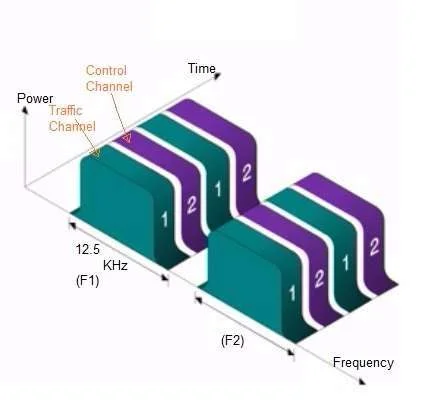DMR | Digital Mobile Radio | DMR Radio basics tutorial
This tutorial covers basics of DMR (Digital Mobile Radio) system. It mentions features of DMR Radio. It mentions DMR network architecture, DMR air interface, DMR channel types, advantages of DMR (Digital Mobile Radio) etc.
There three different DMR Tiers viz. DMR Tier-I, DMR Tier-II and DMR Tier-III.
These are categorized into frequency of operation, transmit power and applications of usage.
Refer DMR Tier-1 to 3➤.
Features of DMR-Digital Mobile Radio
Following table mentions features of DMR i.e. Digital Mobile Radio.
| Specifications | DMR Radio |
|---|---|
| Radio Technology type | Digital |
| Frequency of operation | 446 MHz for DMR Tier-I 66 to 960 MHz for DMR Tier-II and Tier-III |
| Frequency Channel Bandwidth | 12.5 KHz |
| Number of time slots per channel | 2 |
| Access Technique | • FDMA (one band for uplink side and other band for downlink side),
1 pair of frequencies used for Tx/Rx direction. • TDMA (2 time slots per channel) FDMA vs TDMA➤ |
| Traffic type | Both voice calls and data calls are supported |
| Modulation Scheme | 4 state FSK, 4 possible symbols, 4800 symbols/sec, 9600 bits/sec , ASK vs FSK vs PSK➤ |
DMR Air Interface | DMR Channel Types

The figure-1 depicts DMR Air interface. There are two frequency bands viz. uplink band and downlink band. In the uplink and downlink bands, each channels consist of 12.5 KHz bandwidth each. Each channel is further used at two different time slots using TDMA technique. These slots are known as logical channels while frequency is known as physical channel. Hence there are two logical channels per physical channel.
In each physical channel , one logical channel is used for traffic and the other for control information. Traffic channel carries either voice or data information. Control channel is used for various functions viz. manages and controls subscriber unit registration, call requests, channel assignments etc. It periodically broadcasts useful system related informations to DMR portable subscriber units. Control channel can also be used to transmit short data messages in case of emergency situations.
Hence DMR channels are of two types physical channel (i.e. frequency) and logical channel (i.e. time slots). Further, logical channel can be further categorized into traffic channel and control channel based on information carried on it.
DMR Network Architecture

The figure-2 depicts DMR network architecture. As shown DMR consists of two main elements Base station and portable subscriber radio units. The area to be covered using DMR technology is divided into number of cell sites. Each cell site consists of one or more than one Base Stations (BSs). Each Base Station can be interfaced with LAN using IP swithes or with WAN using routers. Often network gateways are used in order to have connectivity with PSTN/PBX to provide connections with analog and digital telephone systems.
Benefits or Advantages of DMR (Digital Mobile Radio)
Following are the benefits or advantages of DMR (Digital Mobile Radio) :
• DMR is a open standard and hence portable DMR handset from one manufacturer can
work with base station from other manufacturer and viceversa.
Moreover portable handsets from two different manufacturers can
communicate or interoperate with each other.
• DMR provides digital quality audio.
This eliminates any external noise and hence can provide better
audio quality even at the edge of the cell of any site.
• It provides double capacity due to two
time slots per channel using TDMA technique.
• It is easy to migrate as it supports both analog and
digital modes.
• DMR handset battery has longer life.
• DMR supports called ID and hence ID of
person who initiates the call is visible to all the recipients.
• DMR offers secured communication
as it uses encryption. Keys are exchanged before the communication
starts so that voice/data goes encrypted over the channel.
• There are numerous applications of DMR (Digital Mobile Radio),
some of these are remote monitoring (telemetry), SCADA, vehicle
automation, GPS etc.
DMR tutorial References
Refer ETSI standards for more information on DMR (Digital Mobile Radio) :
TS 102 361-1 : Air interface protocol
TS 102 361-2 : Voice and Other services
TS 102 361-3 : Data protocol
TS 102 361-4 : Trunking protocol
Other Digital Radio and Analog Radio Systems
TETRA Radio System
Difference between TETRA and TETRA2 system
APCO-25 versus APCO-16
Opensky Radio System
DMR-Digital Mobile Radio
iDEN-Integrate Digital Enhanced Network
